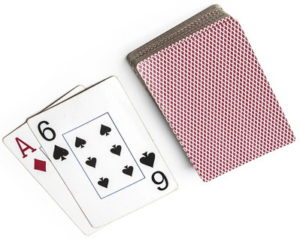 While, in this game of incomplete information, we can’t know what our opponents are holding, knowing which hands your opponent can’t be holding can help us out a lot. This is where blockers come in.
While, in this game of incomplete information, we can’t know what our opponents are holding, knowing which hands your opponent can’t be holding can help us out a lot. This is where blockers come in.
In poker, we call a playing card that effectively blocks an opponent’s ability to complete a hand a blocker. For example, if we are holding an Ace and a King pre flop in a game of Texas Hold’em, there is less of a chance of our opponent holding a pocket pair of Aces seeing as we are holding one of only four Aces in the game.
Typically, there are six alternative ways to make a pair of Aces but with us holding that Ace, we have effectively reduced that number of Aces making to three. Our blocker has sliced the oppo’s chances literally in half. Basically, the term blocker does exactly what it says on the tin. It blocks, it interrupts, hence blocker to mean a card in our hand that makes certain hands for our opponent less likely.
Technically, this is known as the card removal effect, but poker has its own language so this card is expressed as a blocker because it makes certain hands less likely or even completely impossible in your opponents’ poker range. Post flop, of course, a blockers can also be found among the community cards.
How To Use Blockers Pre Flop
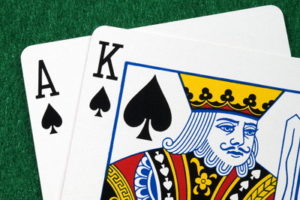 Historically, blockers were likely to have been initially applied to pre flop situations. You can utilise blockers by three bet and four bet bluffing when you are in spots in which you are planning to fold to a re-raise.
Historically, blockers were likely to have been initially applied to pre flop situations. You can utilise blockers by three bet and four bet bluffing when you are in spots in which you are planning to fold to a re-raise.
The very best bluffer hands will be the ones that contain an ace or a king because this eradicates a sizeable amount of your opponent’s pocket aces, pocket kings and ace king combinations.
If you are bluffing with a hand that is likely to make it to the flop, it could work in your favour to hold a hand without blockers because it will have greater equity against your opponent’s pre flop calling range.
When we talk about blockers it is good to be able to count hand combinations in order to calculate how wide our opponent’s range might be in a certain spot. Better still, combining this with an understanding of pot odds will give us the necessary tools to elevate our decision making process by quite a bit.
As an example, let’s say that you are facing a pot bet on the river, the pot odds will inform you that you should be calling with the best hand around 33% of the time in order to break even. If you believe that at least a third of your opponent’s range is made up of bluffs, then using blockers to improve the accuracy of your estimation will make that call a lot easier and more likely to be correct.
Pre Flop Hand Combinations
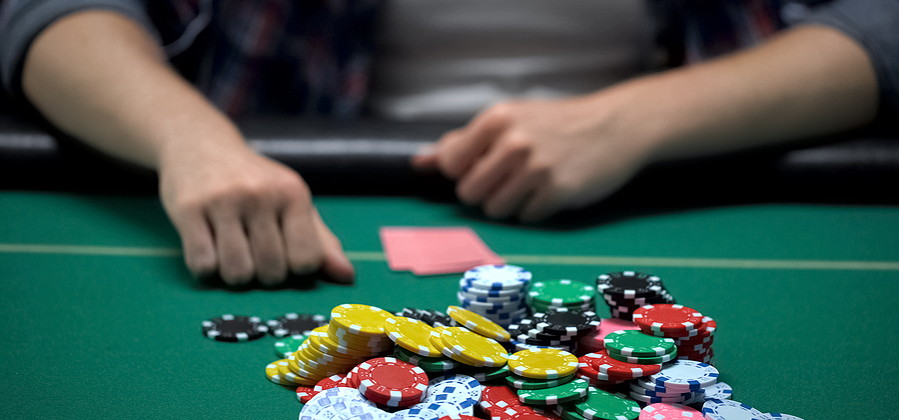
Pre flop, there are:
- 16 combinations of any non-pocket starting hand
- 12 combinations of any off suit hand
- 4 combinations of any suited hand
- 6 combinations of any pocket pair
For example, this means that if you are holding an ace, you will have reduced your opponent’s possible combinations of [AX][KX] from 16 down to 12.
Likewise, the same applies to the amount of [AX][QX] and [AX][JX] with the combinations of pocket now also reduced from six to three.
Post Flop Hand Combinations
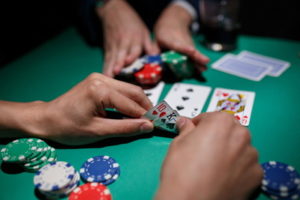 You will also need to consider the removal effects of cards present on the board post flop as well. As an example, let’s say the flop is showing [AX][KX][4X] and we are holding [AX][5X]. Obviously, what this means is that there can only be two remaining aces in the pack.
You will also need to consider the removal effects of cards present on the board post flop as well. As an example, let’s say the flop is showing [AX][KX][4X] and we are holding [AX][5X]. Obviously, what this means is that there can only be two remaining aces in the pack.
In this scenario the amount of hand combinations that contain any one pair ace can be calculated by taking 2×4, where two is the number of remaining aces, and four is the remaining number of 4s. So, in this case we have eight possible combinations of every paired ace.
With pocket pairs, the best thing is to always remember that there will be three combinations for each combination and a single combo for quads. In such a case, an opponent that is able to hold every possible combination of a paired ace has up to 80 combinations of hands which should tell you that you are facing a very wide range. The narrower your opponent’s range is, the more relevant blockers in poker become.
A Detailed Example of Poker Blockers
When we have a good read on a tight aggressive opponent, we know that he only four bets with [AA], [KK], [QQ] and [AK].
Perceived Hand Combinations
| Hand | Combinations |
|---|---|
| AA | Six |
| KK | Six |
| Six | |
| AK | Sixteen |
| Total Combinations = 34 | |
Holding: [KQ]
Seeing as we have a King and a Queen, we need to apply the card removal effects to find the actual combos of our opponent’s range.
Actual Hand Combinations
| Hand | Combinations |
|---|---|
| AA | Six |
| KK | Three |
| Three | |
| AK | Twelve |
| Total Combinations = 24 | |
We can now see that due to poker blockers the total hand combinations is 24 which is 29.4% less than the perceived hand combinations.
Blocker Betting
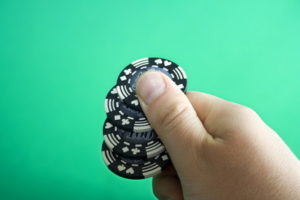 A blocker bet is an advanced poker play. Because betting and raising is generally more advantageous than calling and checking, players often choose to make a blocker bet.
A blocker bet is an advanced poker play. Because betting and raising is generally more advantageous than calling and checking, players often choose to make a blocker bet.
When betting first, the blocking bet is a smaller than normal bet designed to maintain that the natural advantage as well as reducing the chances of seeing the next card because we won’t have to call a larger bet.
How To Use Blockers in Different Situations
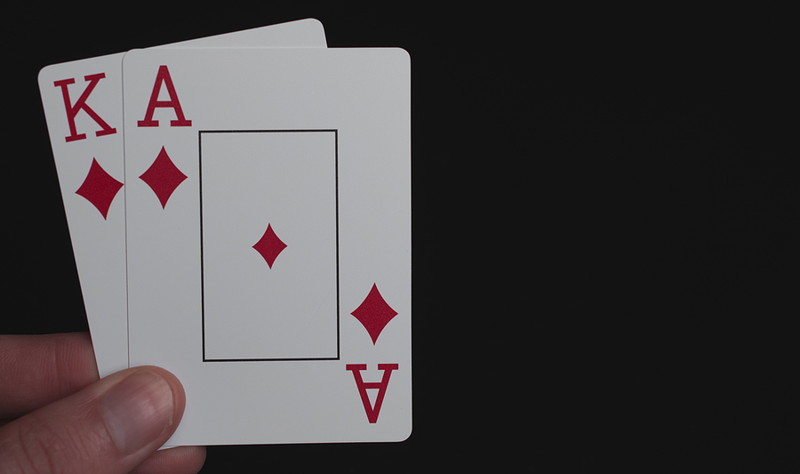
Blockers can be used in a number of different situations and some of the more common spots are when making a pre flop bluff (three or four betting), when making thin calls or making bluffs based on blocker cards.
Big Bluffs On The River
Here you should really be able to see the true value of blockers. You can play a big bet on the river which would suggest that you have the absolute nuts, but it will still be hard for your opponents to know whether or not you are bluffing or actually do have it.
Naturally, the bet size in these spots will normally need to be on the larger side in order to maximise your fold equity. This means that you will need to balance it out by doing the same sometimes when you actually do have the nuts.
Also, always remember to check out your opponent’s stats if it is possible to. If they are someone who doesn’t usually want to fold and will station you with a wide range of hands then there really is not much point in attempting to rep the nuts. This play is only really effective against opponents who will actually have some idea of what it is that you are trying to represent, and they will factor that into their decision making process accordingly.
Bluff Catching
Lastly, you can use blockers when deciding whether or not to make a call when in a difficult spot. This is basically the same move that is applied in bluffing spots but in reverse. If it is you that is holding the ace of hearts but it’s your opponent who is betting relentlessly on all the streets you can stop to think about what it is that they are repping. Since you are aware that they can’t have the nuts, then the question becomes how can they be playing quite so aggressively when they don’t know your holdings.
This can help you to catch the occasional bluff from time to time, especially so on the river where many players will often make huge river bets with polarised ranges when they have the nuts and when they actually have nothing and are trying to put you off your hand. This isn’t to say that you should just start calling people down with ace high hands all the time. A competent poker player will still go for value with a good flush even when it’s not the absolute nuts so don’t level yourself out into thinking that they could only be betting on a bluff.
In cases like these, it is important to consider the entire hand and put together as much information as possible before making your decision. Holding a blocker to the nuts is certainly very valuable but don’t overestimate it, because it could cost you dearly if you do.
Summary
You should be using blockers whenever selecting pre flop bluffing hands because they add more value estimation.
They can also help to increase your post flop success rate, again adding more value to your bluffs. And they even help to make bluff catches. In fact, it’s highly likely that you have been using blockers without even realising it.
